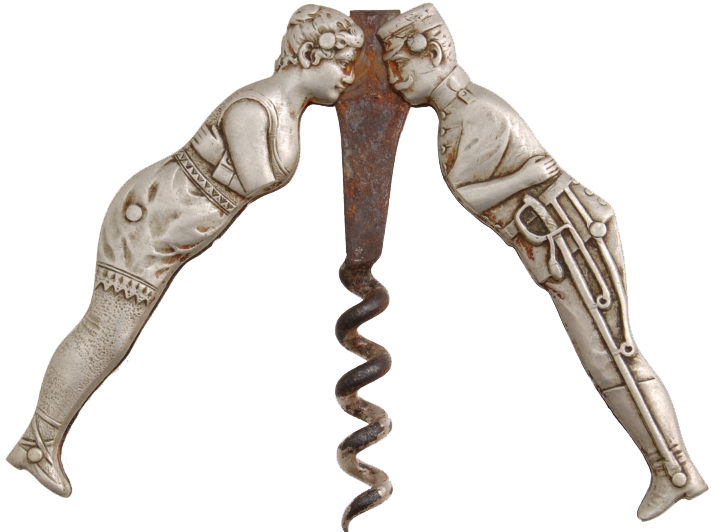
|
|
ANA SAYFA |
|
HAKKIMIZDA |
|
|
ÜRÜNLER |
|
|
REFERANSLAR |
|
|
TİRBUŞON HAKKINDA |
|
|
İLETİŞİM |
|
|
|
|
Tirbuşon Hakkında |
|
 A corkscrew is a kitchen tool for drawing corks from wine bottles. Generally, a corkscrew consists of a pointed metallic helix (often called the "worm") attached to a handle. The user grips the handle and screws the metal point into the cork, until the helix is firmly embedded, then a vertical pull on the corkscrew extracts the cork from the bottle. Corkscrews are necessary because corks themselves, being small and smooth, are difficult to grip and remove, particularly when inserted fully into an inflexible glass bottle. The handle of the corkscrew, often a horizontal bar of wood attached to the screw, allows for a commanding grip to ease removal of the cork. Corkscrew handles may incorporate levers that further increase the amount of force that can be applied outwards upon the cork. A corkscrew is a kitchen tool for drawing corks from wine bottles. Generally, a corkscrew consists of a pointed metallic helix (often called the "worm") attached to a handle. The user grips the handle and screws the metal point into the cork, until the helix is firmly embedded, then a vertical pull on the corkscrew extracts the cork from the bottle. Corkscrews are necessary because corks themselves, being small and smooth, are difficult to grip and remove, particularly when inserted fully into an inflexible glass bottle. The handle of the corkscrew, often a horizontal bar of wood attached to the screw, allows for a commanding grip to ease removal of the cork. Corkscrew handles may incorporate levers that further increase the amount of force that can be applied outwards upon the cork.HISTORY
Its design may have derived from the gun worm which was a device used by musketmen to remove unspent charges from a musket's barrel in a similar fashion, from at least the early 1630s.
The corkscrew is possibly an English invention, due to the tradition of beer and cider, and Treatise on Cider by John Worlidge in 1676 describes "binning of tightly corked cider bottles on their sides", although the earliest reference to a corkscrew is, "steel worm used for the drawing of Corks out of Bottles" from 1681.
In 1795, the first corkscrew patent was granted to the Reverend Samuell Henshall, in England. The clergyman affixed a simple disk, now known as the Henshall Button, between the worm and the shank. The disk prevents the worm from going too deep into the cork, forces the cork to turn with the turning of the crosspiece, and thus breaks the adhesion between the cork and the neck of the bottle. The disk is designed and manufactured slightly concave on the underside, which compresses the top of the cork and helps keep it from breaking apart.
Wing Corkscrew
First invented in 1939, A wing corkscrew, sometimes called a butterfly corkscrew or angel corkscrew, has two levers, one on either side of the worm. As the worm is twisted into the cork, the levers are raised. Pushing down the levers draws the cork from the bottle in one smooth motion. The most common design has a rack and pinion connecting the levers to the body. The head of the central shaft is frequently modified to form a bottle opener, increasing the utility of the device. Corkscrews of this design are particularly popular in household use.
Sommelier Knife
A sommelier knife, waiter's friend or wine key is a corkscrew in a folding body similar to a pocket knife. It was conceived by the German Karl Wienke in 1882 and patented in Germany, England, and America.
An arm extends to brace against the lip of the bottle for leverage when removing the cork. Some sommelier knives have two steps on the lever, and often also a bottle opener. A small hinged knife blade is housed in the handle end for removing the foil wrapping the neck of many wine bottles. Twin Prong Cork Puller
Also known as butler's friend or "Ah-So", the twin-prong cork puller can extract a stopper without damaging it, to allow for sampling the wine before re-inserting the stopper. The stopper is removed by pushing the prongs between the cork and the neck of the bottle, and twisting the stopper out of the bottle. Replacing the stopper involves taking it between the two prongs, then twisting it into the bottle and pulling out the prongs. |
| BORDO INTERNATIONAL TRADE | Tasarım ve Programlama: Webkent Yazılım |